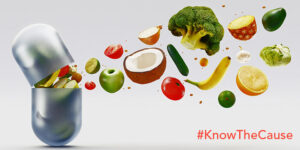

Many people wonder why and how they could possibly have developed a problem with yeast or fungi. The fact is, there are a wide variety of ways through which you can be exposed to fungi.
More often than not, many of these constitute normal, harmless exposures. After all, fungi are ubiquitous––they are everywhere, and there is no escaping them. However, under certain circumstances, fungal exposure can lead to more insidious problems. These are all common ways we can be exposed to fungi and fungal poisons.
Indoor Air
Many people overlook the importance of indoor air quality, particularly in our more modern buildings which are well insulated and sealed off from the elements. In buildings that are contaminated with fungi, whether they have experienced leaks, flooding, or have generally fallen into disrepair. Fungi can even grow in buildings that appear clean; they can lurk behind drywall and in dark, damp spaces with little airflow, such as closets, laundry rooms, or bathrooms. If they do contaminate a space, indoor HVAC can circulate airborne spores and mycotoxins through the air, contaminating the air inside the entire structure.
Outdoor Air
Sometimes, we can be exposed to fungi by the air we breathe outside, too. Fungi are ubiquitous organisms, and their spores can travel for miles on wind streams. In some places, the risk is higher than others; for example, California’s Central Valley is rife with a species of coccidioides fungi that causes the disease known as valley fever; spores can lurk in the air and infect people who simply happen to be in the area.
Through The Soil
If you work in construction or farming, or even if you enjoy gardening, you can be exposed to soil-dwelling fungi. These can enter the bloodstream through cracks or cuts in the skin.
Through Your Diet
Many common foodstuffs are known to be contaminated with molds, which can leave behind poisons even if the mold itself dies. These include foods like grains, especially wheat and corn, soy, peanuts, sugar, potatoes, and many more. These contaminations are more common than many believe, and many regulatory agencies do not screen for the full spectrum of poisons that molds can leave behind. Furthermore, you can be exposed to yeast in foods that use yeast as an ingredient.
Through Medicine
The invention of antibiotics was one of the most important moments of progress in civilization; before, simple infections could easily bloom unchecked into sepsis, killing a person who simply suffered a minor cut or scrape, for example. For all the lives they have saved, however, there are darker sides to these pills once celebrated as silver bullets. Antibiotics are, themselves, toxins (they kill organisms, including people in the right dosage) derived from fungi. Sometimes, they are necessary, and the associated risks of taking them are far less than the risk posed to the infection they are treating. However, antibiotics can devastate the beneficial bacteria in the gut which would otherwise keep yeast at bay, allowing an overgrowth of fungi throughout the gut.
Alcohol And Cigarette Consumption
As if you needed another reason not to smoke: Cigarettes are often made with tobacco that has been cured using sugar, and fungi can often grow on the leaves, possibly contaminating them with mycotoxins.
Alcohol is often made from ingredients that are infested with mold and mycotoxins, including corn, barley, rye, wheat, potatoes, and certain fruits. And, alcohol is fermented using yeast. Alcohol is, itself, a mycotoxin, but it generally always comes with the added risk of mycotoxins which contaminated the foods used to make it.
Mycotoxins Are Not Under Control
Mycotoxin Exposure and Development of Endocrine Problems
Join our LIVE Q&A stream every week if you would like to ask a question! Learn more about the live show and join in here: KTC Too! – Doug Kaufmann’s Know the Cause
Doug Kaufmann has written many books that cover a full range or health issues. Find out which of his books best suits you by clicking the button below.
Doug Kaufmann developed his diet after years studying the clinical effects of pathogenic fungi on the body. Fungi and yeasts can become parasitic organisms on and inside our body, causing health problems that can be difficult to diagnose. Learn more about the Kaufmann Diet, change your life and know the cause.
We encourage all visitors to this site to take some time and study these technical articles prior to initiating lifestyle changes, including dietary changes and to do so with their physician’s awareness and approval. The articles posted in this link are scientific and with few exceptions are taken from medical journals familiar to healthcare workers.
Looking for help assembling antifungal Kaufmann Diet approved recipes for breakfast, lunch or dinner? We have several videos, books and recipe write ups here on Know the Cause that will help your health journey. The recipes in this section are so good, you’ll feel like you’re indulging. No sacrifice needed! Enjoy.
© 2024 Mediatriton Inc. All Rights Reserved • Website by Skynet Solutions